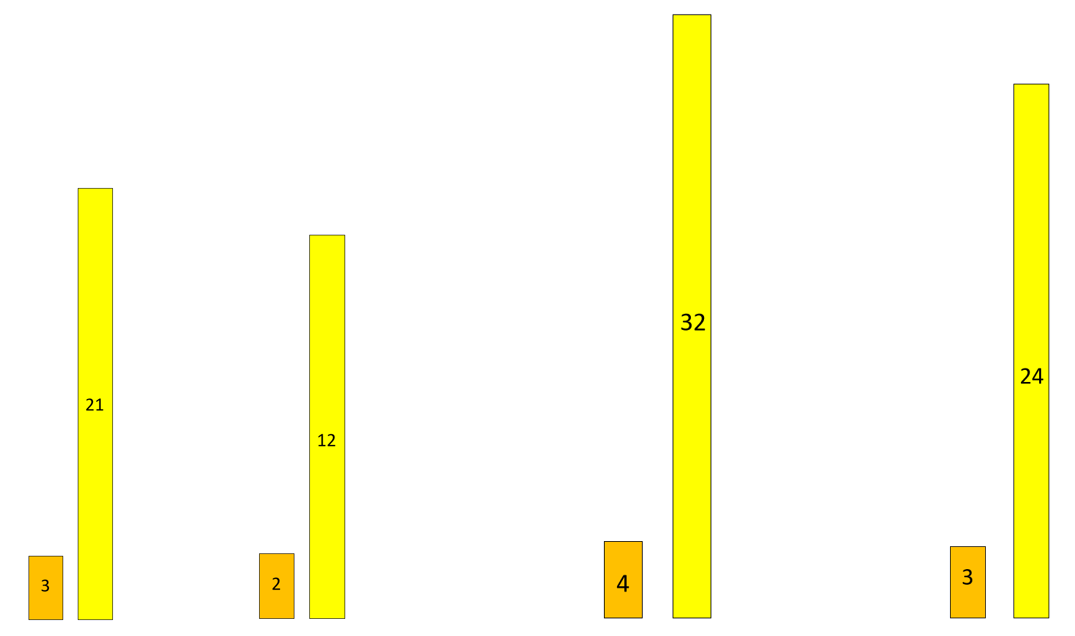Purpose
The purpose of this activity is to support students in applying their knowledge of basic multiplication facts to solve scaling problems. In doing so, students connect multiplication and division as inverse operations.
Achievement Objectives
NA3-1: Use a range of additive and simple multiplicative strategies with whole numbers, fractions, decimals, and percentages.
NA3-2: Know basic multiplication and division facts.
Required Resource Materials
- Connecting cubes
Activity
 Draw two bars representing different stacks of cubes - one 6-cubes tall and one 18-cubes tall. If necessary, alter the number of cubes to better support or extend your students' knowledge. Avoid drawing the individual cubes unless needed for modelling the proportional relationship between the size of the cubes.
Draw two bars representing different stacks of cubes - one 6-cubes tall and one 18-cubes tall. If necessary, alter the number of cubes to better support or extend your students' knowledge. Avoid drawing the individual cubes unless needed for modelling the proportional relationship between the size of the cubes.
- Ask students to tell you what they know about the size of these bars. Record statements and relevant mathematical language next to your bar drawings.
- Have students, in pairs, make up “times as many” sentences about the stacks. Answers might include:
18 is three times as many as 6.
6 is three times less than 18.
- Ask students to share how they worked out the “three times’ relationship. Ideally students will report scanning the multiplication facts for six, such as 1 x 6 = 6, 2 x 6= 12, 3 x 6 = 18. Model this using individual cubes if necessary.
- Record the equation [ ] x 6 = 18.
What do the symbols mean in this equation?
Draw attention to the scaling context by emphasising that the missing factor is the multiplier. This is the scalar (enlargement factor). You might introduce the kupu taurahi (scale factor for enlargement) here.
- Record the equation18 ÷ [ ] = 6.
How is this related to our multiplication equation: [ ] x 6 = 18?
Draw attention to the missing divisor (3) being the scalar in the multiplication equation. Develop wording to match the equations, such as:
“How many times six is equal to 18?”
“How many equal parts should 18 be broken into, to make sixes?”
- Pose similar problems that involve comparing a smaller stack with a larger stack, and vice versa. This should include the following:
- opportunities for students to work with their peers, supporting and being extended by the thinking of others.
- discussion of “times as” statements, such as “32 is 8 times as much as 4” or “3 is 8 times less than 24.”, for each problem.
- recording of multiplication and division statements for each comparison. Include relevant fraction multiplication, such as: 7 x 3 = 21, 21 ÷ 7 = 3 and 1/7 × 21 = 7.
- opportunities for students to share their thinking, diagrams, and language with peers and the wider class.
Examples might include (diagrams not to scale):
- Challenge students to use division to solve missing multiplier problems. Choice of numbers plays an important role in convincing students about the power of division. Begin with facts that students have strong knowledge of, such as twos, fives, and tens.
I have these stacks, a 4-stack, and a 40-stack.
How many times greater is the 40-stack than the 4-stack?
How do you know?
- Discuss students’ methods for solving these problems. Scanning the times-four facts is much less efficient than asking “what number multiplied by four equals 40? ([ ] x 4 = 40)”.
Emphasise that division is the same as looking for the missing multiplier, 40 ÷ 4 = [ ].
- Pose similar unknown multiplier problems with accessible facts, such as:
- I have these stacks, an 8-stack, and a 40-stack.
How many times greater is the 40-stack than the 8-stack? - I have these stacks, a 9-stack, and an 18-stack.
How many times greater is the 18-stack than the 9-stack? - I have these stacks, a 7-stack, and a 35-stack.
How many times greater is the 35-stack than the 7-stack?
- I have these stacks, an 8-stack, and a 40-stack.
Next steps
- Increase the level of abstraction by progressing from diagrams to the use of equations.
- Ask anticipatory questions aimed at divisibility like, “let’s compare 9 to 36. What multiplier might work with these numbers? Why can’t five be the multiplier?”
- Extend the difficulty of the comparisons so students apply a full range of their basic multiplication facts and begin to apply division equivalents of those facts.
- Progress to using simple fraction multipliers, particularly involving halves. For example, “How many times greater is 20 compared to 8? (2 1/2 times).
- Encourage the application of students' basic multiplication facts by presenting them with contextually relevant problems or by asking students to make up similar problems with the use of other relevant materials (e.g. stick figures, animal toys).
Add to plan
Level Three